University Finance Report: Analysis of Commonwealth Bank of Australia
VerifiedAdded on 2023/01/23
|16
|3624
|47
Report
AI Summary
This report provides a comprehensive analysis of the Commonwealth Bank of Australia (CBA), evaluating its performance through a SWOT analysis, examination of naturally occurring data, and critical assessment. The report delves into CBA's strengths, such as its diverse banking services, strong market position, and extensive distribution network, while also addressing weaknesses like sales inventory issues and research and development expenses. The analysis includes insights from conversation and email analysis, corporate artifacts, and an evaluation of the bank's financial position and cost structure. Furthermore, it examines the bank's strategic initiatives, regulatory environment, and opportunities for self-improvement, culminating in a detailed overview of CBA's current standing and future prospects within the financial market. The report also includes a discussion on how the author fits within the organization and how they can contribute to the organization’s goals.
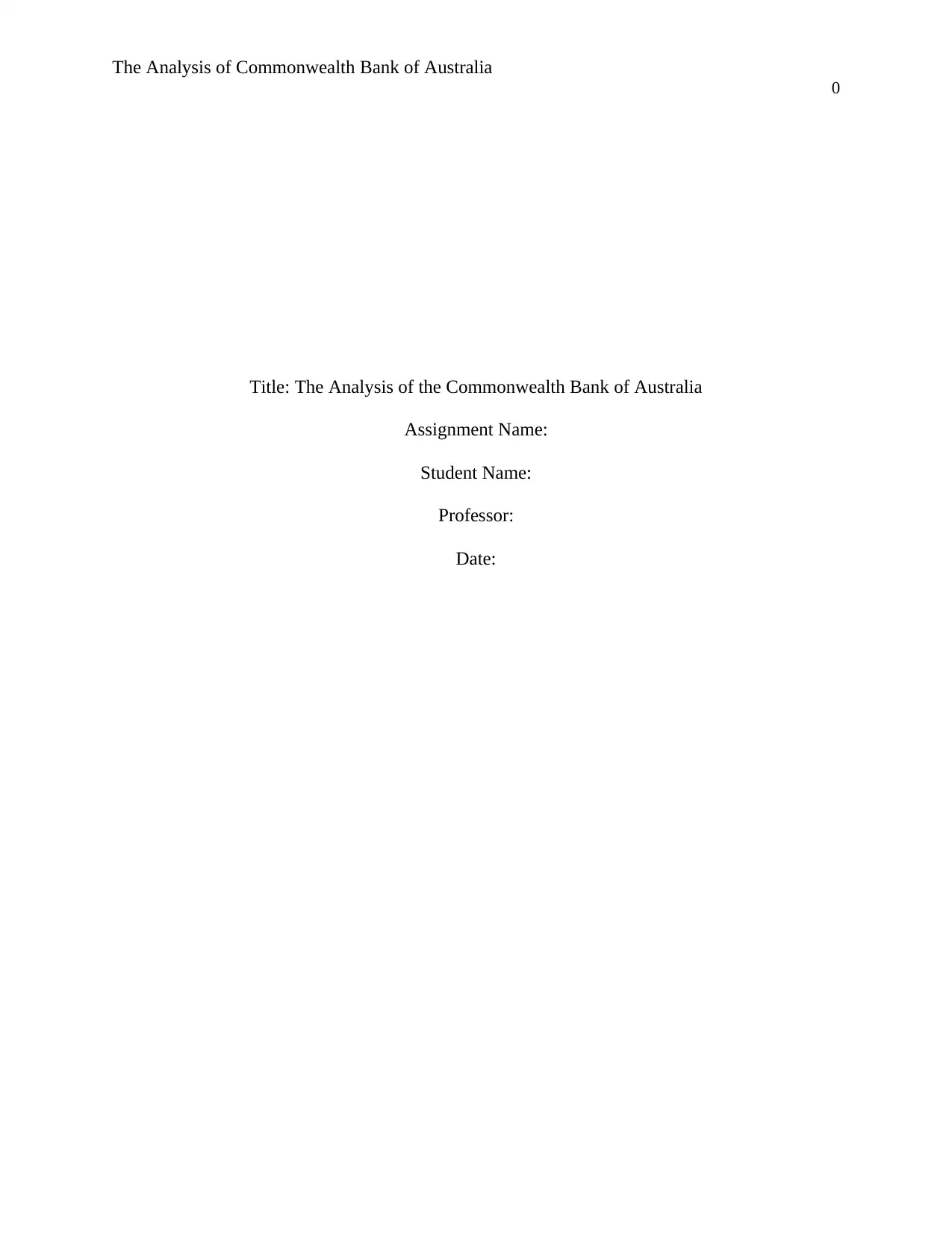
The Analysis of Commonwealth Bank of Australia
0
Title: The Analysis of the Commonwealth Bank of Australia
Assignment Name:
Student Name:
Professor:
Date:
0
Title: The Analysis of the Commonwealth Bank of Australia
Assignment Name:
Student Name:
Professor:
Date:
Paraphrase This Document
Need a fresh take? Get an instant paraphrase of this document with our AI Paraphraser

The Analysis of Commonwealth Bank of Australia
1
Executive Summary
The report summarizes an introduction on Commonwealth Bank of Australia. A brief overview
of a SWOT analysis of Commonwealth Bank of Australia has been provided. The use of
naturally occurring data has been given which is followed by the assessment of its strengths and
weaknesses. A critical assessment of the Commonwealth Bank of Australia has been further
discussed and also the explanation for continuous self-improvement has been given. This is
followed by a conclusion.
1
Executive Summary
The report summarizes an introduction on Commonwealth Bank of Australia. A brief overview
of a SWOT analysis of Commonwealth Bank of Australia has been provided. The use of
naturally occurring data has been given which is followed by the assessment of its strengths and
weaknesses. A critical assessment of the Commonwealth Bank of Australia has been further
discussed and also the explanation for continuous self-improvement has been given. This is
followed by a conclusion.
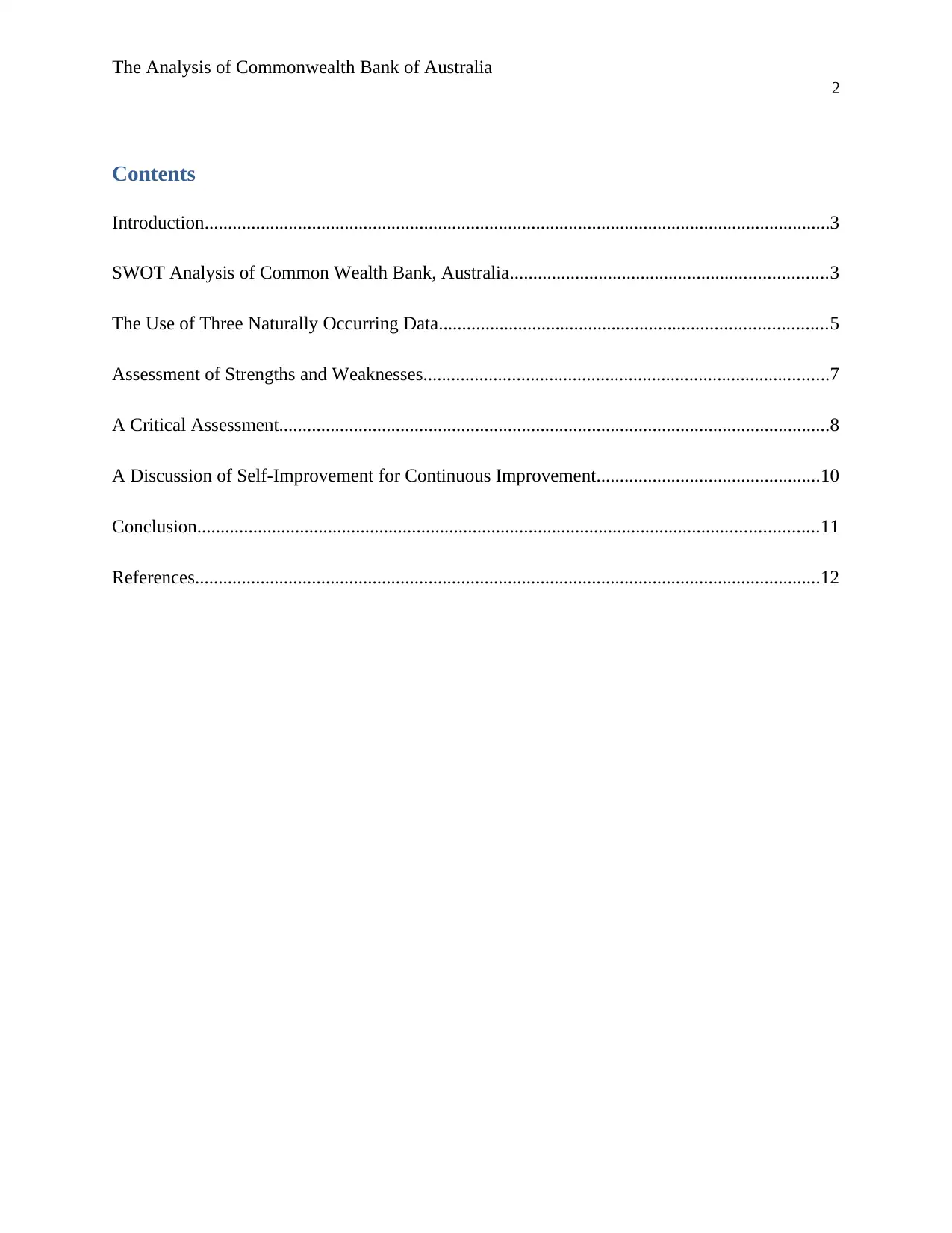
The Analysis of Commonwealth Bank of Australia
2
Contents
Introduction......................................................................................................................................3
SWOT Analysis of Common Wealth Bank, Australia....................................................................3
The Use of Three Naturally Occurring Data...................................................................................5
Assessment of Strengths and Weaknesses.......................................................................................7
A Critical Assessment......................................................................................................................8
A Discussion of Self-Improvement for Continuous Improvement................................................10
Conclusion.....................................................................................................................................11
References......................................................................................................................................12
2
Contents
Introduction......................................................................................................................................3
SWOT Analysis of Common Wealth Bank, Australia....................................................................3
The Use of Three Naturally Occurring Data...................................................................................5
Assessment of Strengths and Weaknesses.......................................................................................7
A Critical Assessment......................................................................................................................8
A Discussion of Self-Improvement for Continuous Improvement................................................10
Conclusion.....................................................................................................................................11
References......................................................................................................................................12
⊘ This is a preview!⊘
Do you want full access?
Subscribe today to unlock all pages.

Trusted by 1+ million students worldwide

The Analysis of Commonwealth Bank of Australia
3
Introduction
The Commonwealth Bank of Australia is commonly known as Australian multinational
bank and businesses spread over New Zealand, Asia, the United Kingdom, and the United States.
The organization provides a wide variety of retail, financial and institutional banking services.
The services also include-insurance, broking, investment, funds management, and
superannuation services. This is the largest bank in Australia and has been listed on the
Australian Securities Exchange. This bank was founded in the year 1911 through Australian
Government and privatized in the year 1996. This is one of the big four banks of Australia and
was listed on the Australian Stock Exchange in the year 1991.
SWOT Analysis of Common Wealth Bank, Australia
The SWOT analysis of Commonwealth Bank, Australia has been given-
Strengths
1. The bank is an owner of various different banks like ASB bank, Commonwealth
securities limited and Bank west and Commonwealth Insurance Limited (Mohammad
Arabzad an, 2012).
2. The bank has been running operations in different countries like New Zealand, USA,
United Kingdom, and Fiji.
3. The bank is regarded as big four Australian Banks and in the same league similar to
ANZ, Westpac, and National Australian Bank.
4. The bank is regarded as the largest Australian listed organization on the Australian
Securities Exchange (Kawai, 2017).
3
Introduction
The Commonwealth Bank of Australia is commonly known as Australian multinational
bank and businesses spread over New Zealand, Asia, the United Kingdom, and the United States.
The organization provides a wide variety of retail, financial and institutional banking services.
The services also include-insurance, broking, investment, funds management, and
superannuation services. This is the largest bank in Australia and has been listed on the
Australian Securities Exchange. This bank was founded in the year 1911 through Australian
Government and privatized in the year 1996. This is one of the big four banks of Australia and
was listed on the Australian Stock Exchange in the year 1991.
SWOT Analysis of Common Wealth Bank, Australia
The SWOT analysis of Commonwealth Bank, Australia has been given-
Strengths
1. The bank is an owner of various different banks like ASB bank, Commonwealth
securities limited and Bank west and Commonwealth Insurance Limited (Mohammad
Arabzad an, 2012).
2. The bank has been running operations in different countries like New Zealand, USA,
United Kingdom, and Fiji.
3. The bank is regarded as big four Australian Banks and in the same league similar to
ANZ, Westpac, and National Australian Bank.
4. The bank is regarded as the largest Australian listed organization on the Australian
Securities Exchange (Kawai, 2017).
Paraphrase This Document
Need a fresh take? Get an instant paraphrase of this document with our AI Paraphraser
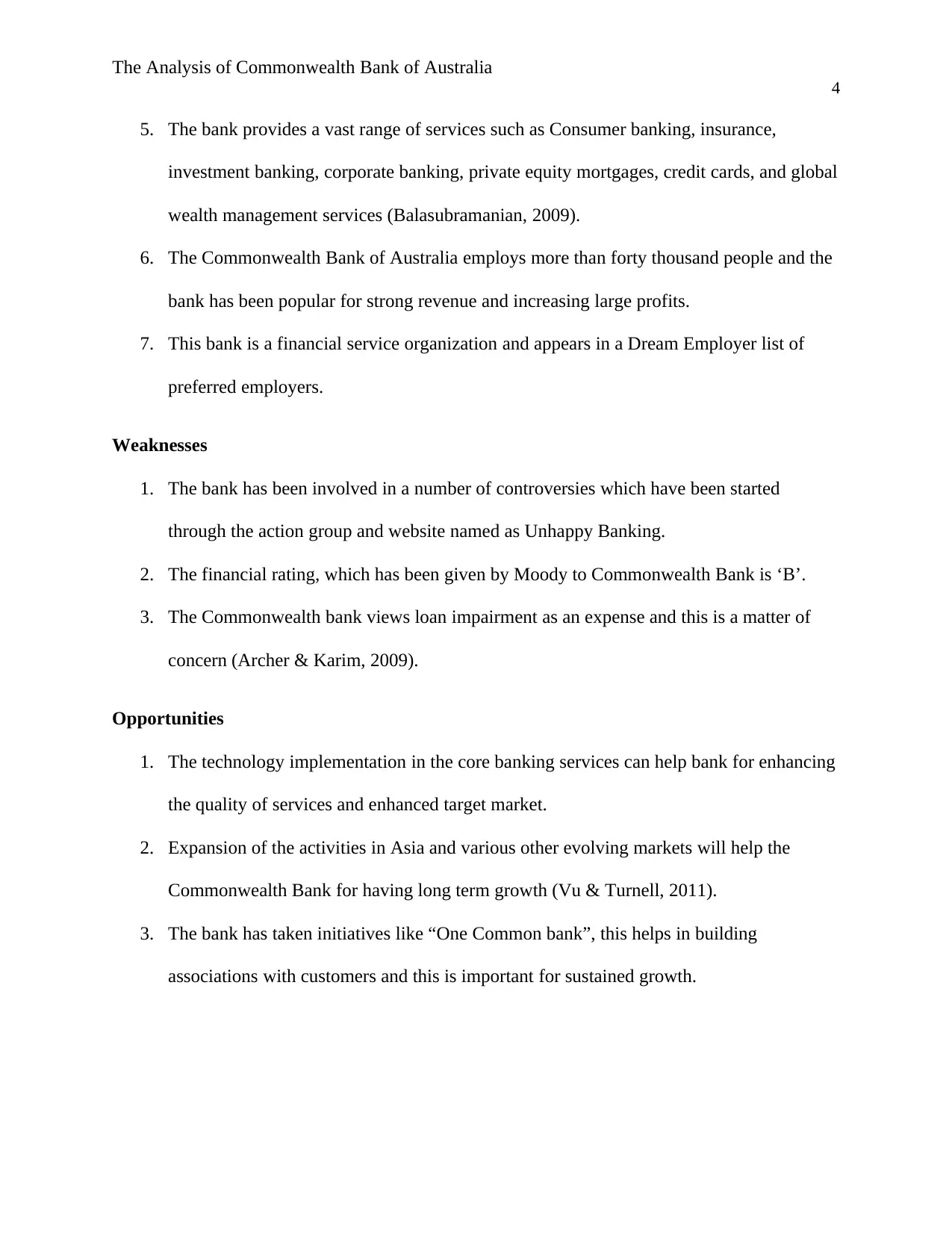
The Analysis of Commonwealth Bank of Australia
4
5. The bank provides a vast range of services such as Consumer banking, insurance,
investment banking, corporate banking, private equity mortgages, credit cards, and global
wealth management services (Balasubramanian, 2009).
6. The Commonwealth Bank of Australia employs more than forty thousand people and the
bank has been popular for strong revenue and increasing large profits.
7. This bank is a financial service organization and appears in a Dream Employer list of
preferred employers.
Weaknesses
1. The bank has been involved in a number of controversies which have been started
through the action group and website named as Unhappy Banking.
2. The financial rating, which has been given by Moody to Commonwealth Bank is ‘B’.
3. The Commonwealth bank views loan impairment as an expense and this is a matter of
concern (Archer & Karim, 2009).
Opportunities
1. The technology implementation in the core banking services can help bank for enhancing
the quality of services and enhanced target market.
2. Expansion of the activities in Asia and various other evolving markets will help the
Commonwealth Bank for having long term growth (Vu & Turnell, 2011).
3. The bank has taken initiatives like “One Common bank”, this helps in building
associations with customers and this is important for sustained growth.
4
5. The bank provides a vast range of services such as Consumer banking, insurance,
investment banking, corporate banking, private equity mortgages, credit cards, and global
wealth management services (Balasubramanian, 2009).
6. The Commonwealth Bank of Australia employs more than forty thousand people and the
bank has been popular for strong revenue and increasing large profits.
7. This bank is a financial service organization and appears in a Dream Employer list of
preferred employers.
Weaknesses
1. The bank has been involved in a number of controversies which have been started
through the action group and website named as Unhappy Banking.
2. The financial rating, which has been given by Moody to Commonwealth Bank is ‘B’.
3. The Commonwealth bank views loan impairment as an expense and this is a matter of
concern (Archer & Karim, 2009).
Opportunities
1. The technology implementation in the core banking services can help bank for enhancing
the quality of services and enhanced target market.
2. Expansion of the activities in Asia and various other evolving markets will help the
Commonwealth Bank for having long term growth (Vu & Turnell, 2011).
3. The bank has taken initiatives like “One Common bank”, this helps in building
associations with customers and this is important for sustained growth.
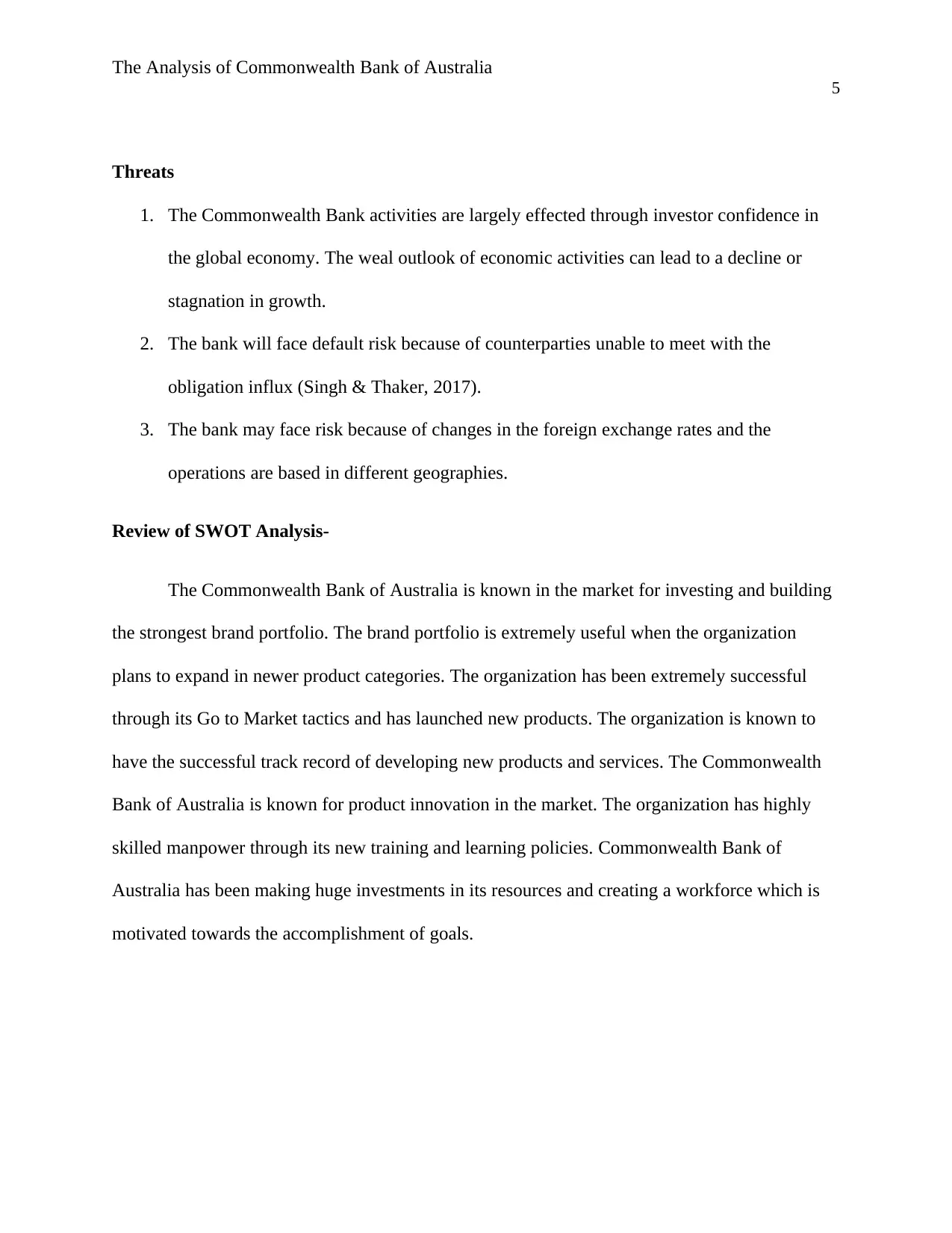
The Analysis of Commonwealth Bank of Australia
5
Threats
1. The Commonwealth Bank activities are largely effected through investor confidence in
the global economy. The weal outlook of economic activities can lead to a decline or
stagnation in growth.
2. The bank will face default risk because of counterparties unable to meet with the
obligation influx (Singh & Thaker, 2017).
3. The bank may face risk because of changes in the foreign exchange rates and the
operations are based in different geographies.
Review of SWOT Analysis-
The Commonwealth Bank of Australia is known in the market for investing and building
the strongest brand portfolio. The brand portfolio is extremely useful when the organization
plans to expand in newer product categories. The organization has been extremely successful
through its Go to Market tactics and has launched new products. The organization is known to
have the successful track record of developing new products and services. The Commonwealth
Bank of Australia is known for product innovation in the market. The organization has highly
skilled manpower through its new training and learning policies. Commonwealth Bank of
Australia has been making huge investments in its resources and creating a workforce which is
motivated towards the accomplishment of goals.
5
Threats
1. The Commonwealth Bank activities are largely effected through investor confidence in
the global economy. The weal outlook of economic activities can lead to a decline or
stagnation in growth.
2. The bank will face default risk because of counterparties unable to meet with the
obligation influx (Singh & Thaker, 2017).
3. The bank may face risk because of changes in the foreign exchange rates and the
operations are based in different geographies.
Review of SWOT Analysis-
The Commonwealth Bank of Australia is known in the market for investing and building
the strongest brand portfolio. The brand portfolio is extremely useful when the organization
plans to expand in newer product categories. The organization has been extremely successful
through its Go to Market tactics and has launched new products. The organization is known to
have the successful track record of developing new products and services. The Commonwealth
Bank of Australia is known for product innovation in the market. The organization has highly
skilled manpower through its new training and learning policies. Commonwealth Bank of
Australia has been making huge investments in its resources and creating a workforce which is
motivated towards the accomplishment of goals.
⊘ This is a preview!⊘
Do you want full access?
Subscribe today to unlock all pages.

Trusted by 1+ million students worldwide
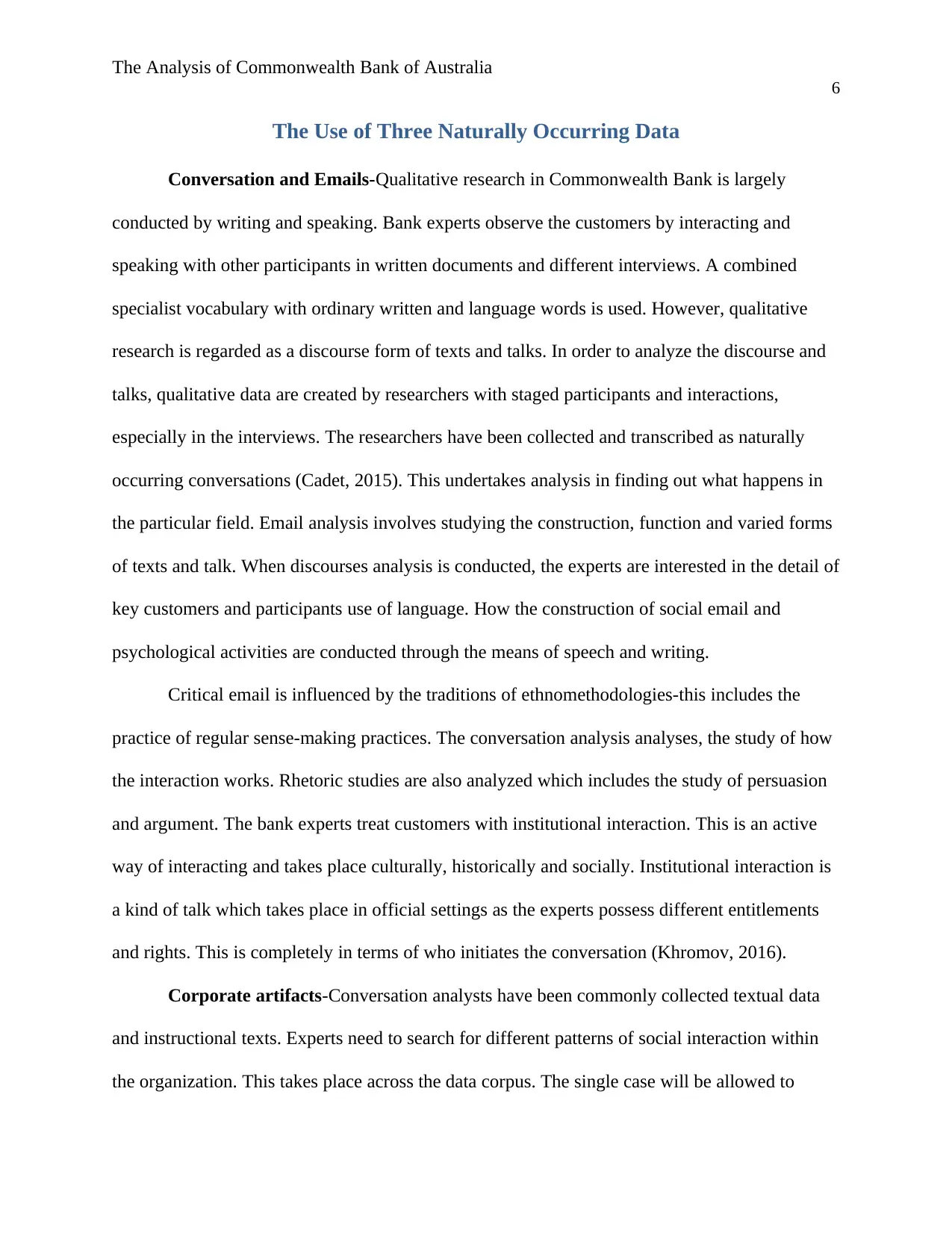
The Analysis of Commonwealth Bank of Australia
6
The Use of Three Naturally Occurring Data
Conversation and Emails-Qualitative research in Commonwealth Bank is largely
conducted by writing and speaking. Bank experts observe the customers by interacting and
speaking with other participants in written documents and different interviews. A combined
specialist vocabulary with ordinary written and language words is used. However, qualitative
research is regarded as a discourse form of texts and talks. In order to analyze the discourse and
talks, qualitative data are created by researchers with staged participants and interactions,
especially in the interviews. The researchers have been collected and transcribed as naturally
occurring conversations (Cadet, 2015). This undertakes analysis in finding out what happens in
the particular field. Email analysis involves studying the construction, function and varied forms
of texts and talk. When discourses analysis is conducted, the experts are interested in the detail of
key customers and participants use of language. How the construction of social email and
psychological activities are conducted through the means of speech and writing.
Critical email is influenced by the traditions of ethnomethodologies-this includes the
practice of regular sense-making practices. The conversation analysis analyses, the study of how
the interaction works. Rhetoric studies are also analyzed which includes the study of persuasion
and argument. The bank experts treat customers with institutional interaction. This is an active
way of interacting and takes place culturally, historically and socially. Institutional interaction is
a kind of talk which takes place in official settings as the experts possess different entitlements
and rights. This is completely in terms of who initiates the conversation (Khromov, 2016).
Corporate artifacts-Conversation analysts have been commonly collected textual data
and instructional texts. Experts need to search for different patterns of social interaction within
the organization. This takes place across the data corpus. The single case will be allowed to
6
The Use of Three Naturally Occurring Data
Conversation and Emails-Qualitative research in Commonwealth Bank is largely
conducted by writing and speaking. Bank experts observe the customers by interacting and
speaking with other participants in written documents and different interviews. A combined
specialist vocabulary with ordinary written and language words is used. However, qualitative
research is regarded as a discourse form of texts and talks. In order to analyze the discourse and
talks, qualitative data are created by researchers with staged participants and interactions,
especially in the interviews. The researchers have been collected and transcribed as naturally
occurring conversations (Cadet, 2015). This undertakes analysis in finding out what happens in
the particular field. Email analysis involves studying the construction, function and varied forms
of texts and talk. When discourses analysis is conducted, the experts are interested in the detail of
key customers and participants use of language. How the construction of social email and
psychological activities are conducted through the means of speech and writing.
Critical email is influenced by the traditions of ethnomethodologies-this includes the
practice of regular sense-making practices. The conversation analysis analyses, the study of how
the interaction works. Rhetoric studies are also analyzed which includes the study of persuasion
and argument. The bank experts treat customers with institutional interaction. This is an active
way of interacting and takes place culturally, historically and socially. Institutional interaction is
a kind of talk which takes place in official settings as the experts possess different entitlements
and rights. This is completely in terms of who initiates the conversation (Khromov, 2016).
Corporate artifacts-Conversation analysts have been commonly collected textual data
and instructional texts. Experts need to search for different patterns of social interaction within
the organization. This takes place across the data corpus. The single case will be allowed to
Paraphrase This Document
Need a fresh take? Get an instant paraphrase of this document with our AI Paraphraser

The Analysis of Commonwealth Bank of Australia
7
analyze the corporate artifacts in detail and sequence of trust takes place in an interaction.
However, there are different varieties of interaction analysis. There is no agreed methodology.
One of the commonly used methodologies to analyze the little words is through broader sense
making patterns. This involves capturing the conversations which are said through experts and
conducting the interaction with contextualizing. This involves analyzing the specific
conversation through naturally occurring data (Merz & Overesch, 2014).
Tracing the mind, when an individual thinks, write or speak, but will be using the shared
common sense and languages. When corporate artifacts are used, then people will be entering
into long conversations. Analysis can start with mindfulness movement. This has been integrated
with western institutions like the Commonwealth Bank of Australia like business and education.
Tracing the interactions and common sense of languages of body and mind is significant. This
also involves present history, specifically the corporate artifacts used in the present moment and
acceptance-based conversations. This is drawn upon modern practices (Jayaraman & Srinivasan,
2014).
Assessment of Strengths and Weaknesses
The assessment of strengths and weaknesses have been given below-
Strengths
1. Reach and Distribution-Commonwealth Bank of Australia has a huge number of outlets
in every state. This is supported through string distribution of network, which makes sure
the products and services are easily available to the number of customers and that too in a
timely manner.
7
analyze the corporate artifacts in detail and sequence of trust takes place in an interaction.
However, there are different varieties of interaction analysis. There is no agreed methodology.
One of the commonly used methodologies to analyze the little words is through broader sense
making patterns. This involves capturing the conversations which are said through experts and
conducting the interaction with contextualizing. This involves analyzing the specific
conversation through naturally occurring data (Merz & Overesch, 2014).
Tracing the mind, when an individual thinks, write or speak, but will be using the shared
common sense and languages. When corporate artifacts are used, then people will be entering
into long conversations. Analysis can start with mindfulness movement. This has been integrated
with western institutions like the Commonwealth Bank of Australia like business and education.
Tracing the interactions and common sense of languages of body and mind is significant. This
also involves present history, specifically the corporate artifacts used in the present moment and
acceptance-based conversations. This is drawn upon modern practices (Jayaraman & Srinivasan,
2014).
Assessment of Strengths and Weaknesses
The assessment of strengths and weaknesses have been given below-
Strengths
1. Reach and Distribution-Commonwealth Bank of Australia has a huge number of outlets
in every state. This is supported through string distribution of network, which makes sure
the products and services are easily available to the number of customers and that too in a
timely manner.
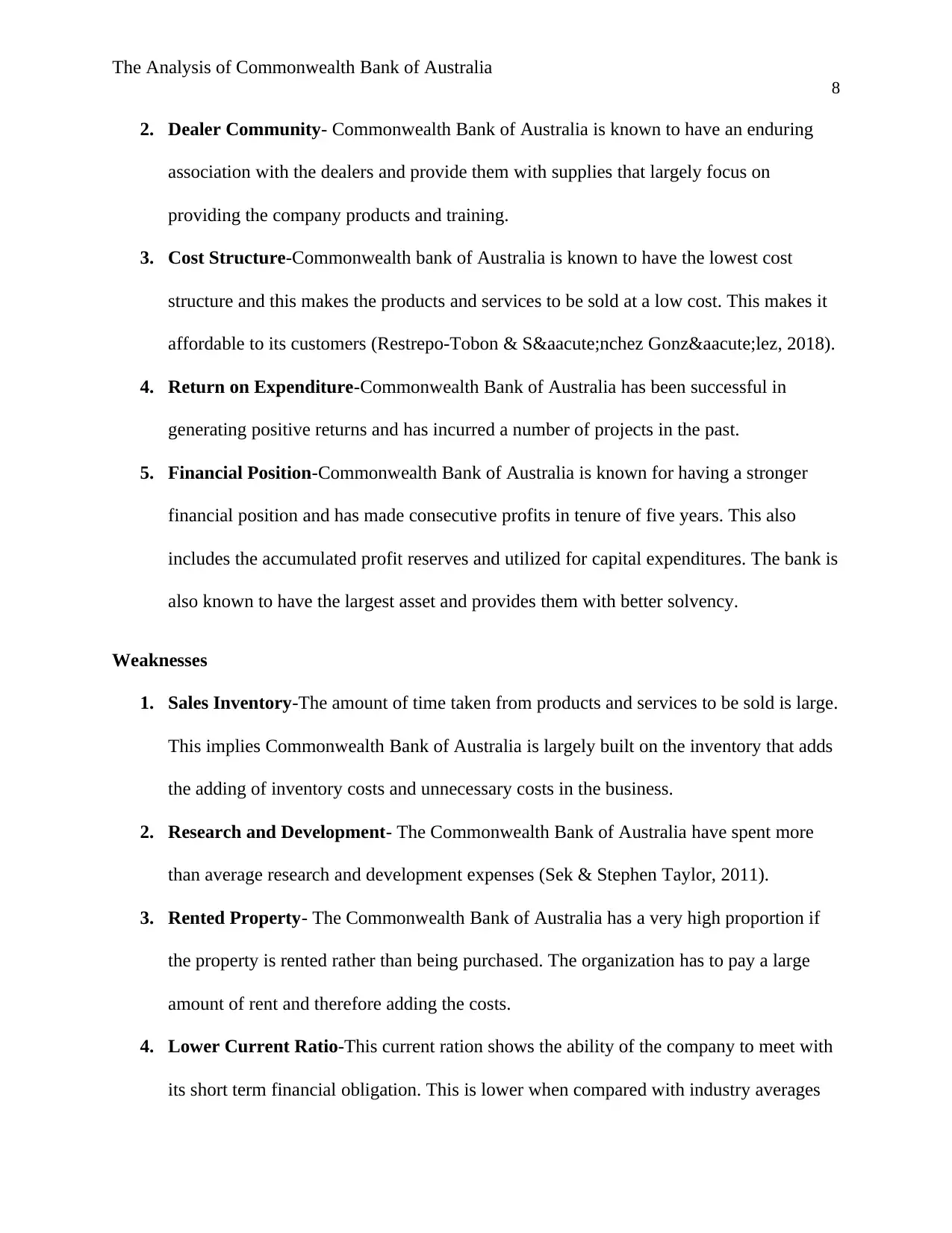
The Analysis of Commonwealth Bank of Australia
8
2. Dealer Community- Commonwealth Bank of Australia is known to have an enduring
association with the dealers and provide them with supplies that largely focus on
providing the company products and training.
3. Cost Structure-Commonwealth bank of Australia is known to have the lowest cost
structure and this makes the products and services to be sold at a low cost. This makes it
affordable to its customers (Restrepo-Tobon & Sánchez González, 2018).
4. Return on Expenditure-Commonwealth Bank of Australia has been successful in
generating positive returns and has incurred a number of projects in the past.
5. Financial Position-Commonwealth Bank of Australia is known for having a stronger
financial position and has made consecutive profits in tenure of five years. This also
includes the accumulated profit reserves and utilized for capital expenditures. The bank is
also known to have the largest asset and provides them with better solvency.
Weaknesses
1. Sales Inventory-The amount of time taken from products and services to be sold is large.
This implies Commonwealth Bank of Australia is largely built on the inventory that adds
the adding of inventory costs and unnecessary costs in the business.
2. Research and Development- The Commonwealth Bank of Australia have spent more
than average research and development expenses (Sek & Stephen Taylor, 2011).
3. Rented Property- The Commonwealth Bank of Australia has a very high proportion if
the property is rented rather than being purchased. The organization has to pay a large
amount of rent and therefore adding the costs.
4. Lower Current Ratio-This current ration shows the ability of the company to meet with
its short term financial obligation. This is lower when compared with industry averages
8
2. Dealer Community- Commonwealth Bank of Australia is known to have an enduring
association with the dealers and provide them with supplies that largely focus on
providing the company products and training.
3. Cost Structure-Commonwealth bank of Australia is known to have the lowest cost
structure and this makes the products and services to be sold at a low cost. This makes it
affordable to its customers (Restrepo-Tobon & Sánchez González, 2018).
4. Return on Expenditure-Commonwealth Bank of Australia has been successful in
generating positive returns and has incurred a number of projects in the past.
5. Financial Position-Commonwealth Bank of Australia is known for having a stronger
financial position and has made consecutive profits in tenure of five years. This also
includes the accumulated profit reserves and utilized for capital expenditures. The bank is
also known to have the largest asset and provides them with better solvency.
Weaknesses
1. Sales Inventory-The amount of time taken from products and services to be sold is large.
This implies Commonwealth Bank of Australia is largely built on the inventory that adds
the adding of inventory costs and unnecessary costs in the business.
2. Research and Development- The Commonwealth Bank of Australia have spent more
than average research and development expenses (Sek & Stephen Taylor, 2011).
3. Rented Property- The Commonwealth Bank of Australia has a very high proportion if
the property is rented rather than being purchased. The organization has to pay a large
amount of rent and therefore adding the costs.
4. Lower Current Ratio-This current ration shows the ability of the company to meet with
its short term financial obligation. This is lower when compared with industry averages
⊘ This is a preview!⊘
Do you want full access?
Subscribe today to unlock all pages.

Trusted by 1+ million students worldwide
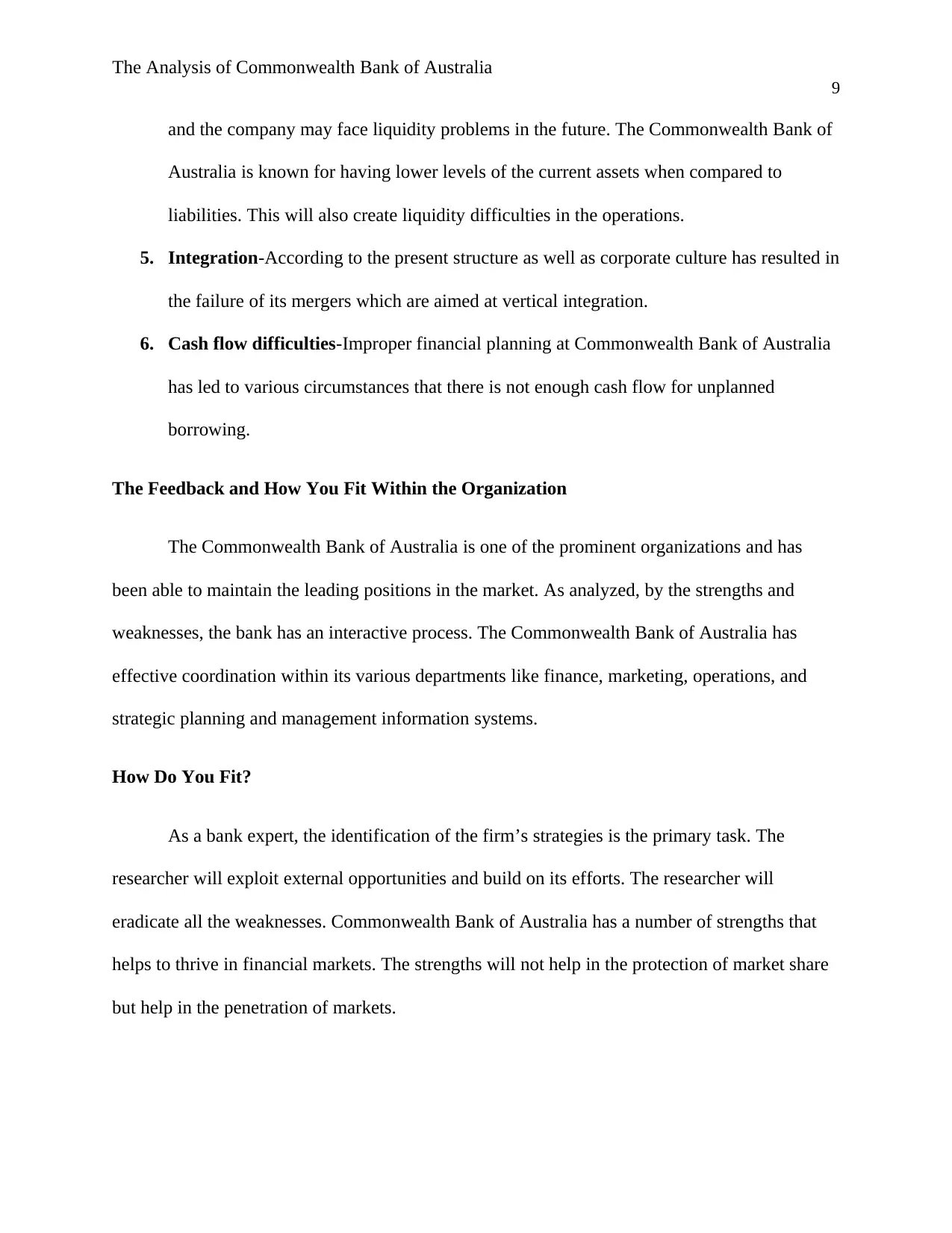
The Analysis of Commonwealth Bank of Australia
9
and the company may face liquidity problems in the future. The Commonwealth Bank of
Australia is known for having lower levels of the current assets when compared to
liabilities. This will also create liquidity difficulties in the operations.
5. Integration-According to the present structure as well as corporate culture has resulted in
the failure of its mergers which are aimed at vertical integration.
6. Cash flow difficulties-Improper financial planning at Commonwealth Bank of Australia
has led to various circumstances that there is not enough cash flow for unplanned
borrowing.
The Feedback and How You Fit Within the Organization
The Commonwealth Bank of Australia is one of the prominent organizations and has
been able to maintain the leading positions in the market. As analyzed, by the strengths and
weaknesses, the bank has an interactive process. The Commonwealth Bank of Australia has
effective coordination within its various departments like finance, marketing, operations, and
strategic planning and management information systems.
How Do You Fit?
As a bank expert, the identification of the firm’s strategies is the primary task. The
researcher will exploit external opportunities and build on its efforts. The researcher will
eradicate all the weaknesses. Commonwealth Bank of Australia has a number of strengths that
helps to thrive in financial markets. The strengths will not help in the protection of market share
but help in the penetration of markets.
9
and the company may face liquidity problems in the future. The Commonwealth Bank of
Australia is known for having lower levels of the current assets when compared to
liabilities. This will also create liquidity difficulties in the operations.
5. Integration-According to the present structure as well as corporate culture has resulted in
the failure of its mergers which are aimed at vertical integration.
6. Cash flow difficulties-Improper financial planning at Commonwealth Bank of Australia
has led to various circumstances that there is not enough cash flow for unplanned
borrowing.
The Feedback and How You Fit Within the Organization
The Commonwealth Bank of Australia is one of the prominent organizations and has
been able to maintain the leading positions in the market. As analyzed, by the strengths and
weaknesses, the bank has an interactive process. The Commonwealth Bank of Australia has
effective coordination within its various departments like finance, marketing, operations, and
strategic planning and management information systems.
How Do You Fit?
As a bank expert, the identification of the firm’s strategies is the primary task. The
researcher will exploit external opportunities and build on its efforts. The researcher will
eradicate all the weaknesses. Commonwealth Bank of Australia has a number of strengths that
helps to thrive in financial markets. The strengths will not help in the protection of market share
but help in the penetration of markets.
Paraphrase This Document
Need a fresh take? Get an instant paraphrase of this document with our AI Paraphraser

The Analysis of Commonwealth Bank of Australia
10
A Critical Assessment
The Commonwealth Bank of Australia firmly believes there is less scope for reducing the
expenditure and improvement in customer outcomes through industry-led and proactive
initiatives. For instance-Providing the customers with better visibility and the trajectory of
superannuation savings along with satisfying disclosure of insurance products and decreased the
scope of fraud through improvised data analytics. In relation to the superannuation system, there
is an introduction of regulation which comes under the strong financial advice and reforms must
be done before the implementation of additional regulatory intervention. Costs are also decreased
through the implementation of regulatory overlap which exists between the investment
committee and Australian Securities and Prudential Regulatory Authority of Australia. The
significance of creating a balance between growth and risk must be relevant to the
recommendation on the regulatory system (Tahir, Bakar & Haron, 2010). Commonwealth Bank
of Australia firmly believes that there are considerable risks involved with the adoption of
obligations on the regulatory capital which have exceeded the commitments. Risks include the
unnecessary constraint on the bank’s ability to sourcing the funds and its capacity of extending
credit. This is vital for supporting the economic growth of Australia. In addition, Australia will
be incurring the multiple regulatory changes which are in relation with jurisdictions which needs
to be aligned with regulatory changes for the set-up of standards (Wafaretta, Rosidi & Rahman,
2016).
Commonwealth Bank has urged the Australian government to consider the implications
associated with developments in the international regulatory system and the maintenance of the
supervisory framework. In summary, Commonwealth Bank of Australia believes that
government will be required to maintain the minimal and efficient cost of the regulatory system
10
A Critical Assessment
The Commonwealth Bank of Australia firmly believes there is less scope for reducing the
expenditure and improvement in customer outcomes through industry-led and proactive
initiatives. For instance-Providing the customers with better visibility and the trajectory of
superannuation savings along with satisfying disclosure of insurance products and decreased the
scope of fraud through improvised data analytics. In relation to the superannuation system, there
is an introduction of regulation which comes under the strong financial advice and reforms must
be done before the implementation of additional regulatory intervention. Costs are also decreased
through the implementation of regulatory overlap which exists between the investment
committee and Australian Securities and Prudential Regulatory Authority of Australia. The
significance of creating a balance between growth and risk must be relevant to the
recommendation on the regulatory system (Tahir, Bakar & Haron, 2010). Commonwealth Bank
of Australia firmly believes that there are considerable risks involved with the adoption of
obligations on the regulatory capital which have exceeded the commitments. Risks include the
unnecessary constraint on the bank’s ability to sourcing the funds and its capacity of extending
credit. This is vital for supporting the economic growth of Australia. In addition, Australia will
be incurring the multiple regulatory changes which are in relation with jurisdictions which needs
to be aligned with regulatory changes for the set-up of standards (Wafaretta, Rosidi & Rahman,
2016).
Commonwealth Bank has urged the Australian government to consider the implications
associated with developments in the international regulatory system and the maintenance of the
supervisory framework. In summary, Commonwealth Bank of Australia believes that
government will be required to maintain the minimal and efficient cost of the regulatory system

The Analysis of Commonwealth Bank of Australia
11
and support with confidence and providing the businesses and individuals with optimism for
investing and embracing the economic opportunities. Commonwealth Bank supports the robust
stability framework and provides for the stable foundation for its financial system. The
commonwealth bank of Australia has been committed to ensuring that it has a sound and stable
framework and capital ratios must be recognized (Al-Farisi & Hendrawan, 2011).
A Discussion of Self-Improvement for Continuous Improvement
Fundamentally, organizations are combating commoditization and rapid innovation
implies that competitive advantage results solely from technical excellence. The product quality-
there has been a dramatic increase in product complexity. This is to the point where quality and
brands differ a lot. Likewise, there are customer satisfaction gaps and these must be given vital
importance. What increasingly matters is human capabilities that are related to how the
Commonwealth Bank of Australia communicates and work with its customers. A single
unsatisfied poorer service encounter will create real reputational damage. This can be amplified
in the social media towards the potential audience which is in hundred million (Yuksel, Canoz &
Ozsarı, 2017).
In this real-based environment, long-lasting competitive advantage will come through the
ability of learning, responding faster and developing the ties with its customers. Technologies
will play a crucial role. According to the market research, more than 60 percent of the activity
must be automated and this will free the people for valuable contributions. There are
organizations which think technology alone can get them out of the competitive role. When
focused on the latest algorithm or any big data processing platform or application, corporate
leaders can lose the sight of how new techniques will be supposed to di. This will help the clients
11
and support with confidence and providing the businesses and individuals with optimism for
investing and embracing the economic opportunities. Commonwealth Bank supports the robust
stability framework and provides for the stable foundation for its financial system. The
commonwealth bank of Australia has been committed to ensuring that it has a sound and stable
framework and capital ratios must be recognized (Al-Farisi & Hendrawan, 2011).
A Discussion of Self-Improvement for Continuous Improvement
Fundamentally, organizations are combating commoditization and rapid innovation
implies that competitive advantage results solely from technical excellence. The product quality-
there has been a dramatic increase in product complexity. This is to the point where quality and
brands differ a lot. Likewise, there are customer satisfaction gaps and these must be given vital
importance. What increasingly matters is human capabilities that are related to how the
Commonwealth Bank of Australia communicates and work with its customers. A single
unsatisfied poorer service encounter will create real reputational damage. This can be amplified
in the social media towards the potential audience which is in hundred million (Yuksel, Canoz &
Ozsarı, 2017).
In this real-based environment, long-lasting competitive advantage will come through the
ability of learning, responding faster and developing the ties with its customers. Technologies
will play a crucial role. According to the market research, more than 60 percent of the activity
must be automated and this will free the people for valuable contributions. There are
organizations which think technology alone can get them out of the competitive role. When
focused on the latest algorithm or any big data processing platform or application, corporate
leaders can lose the sight of how new techniques will be supposed to di. This will help the clients
⊘ This is a preview!⊘
Do you want full access?
Subscribe today to unlock all pages.

Trusted by 1+ million students worldwide
1 out of 16
Related Documents
Your All-in-One AI-Powered Toolkit for Academic Success.
+13062052269
info@desklib.com
Available 24*7 on WhatsApp / Email
![[object Object]](/_next/static/media/star-bottom.7253800d.svg)
Unlock your academic potential
Copyright © 2020–2025 A2Z Services. All Rights Reserved. Developed and managed by ZUCOL.




